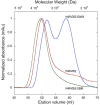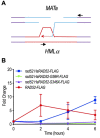Variants of the human RAD52 gene confer defects in ionizing radiation resistance and homologous recombination repair in budding yeast
- PMID: 33015141
- PMCID: PMC7517009
- DOI: 10.15698/mic2020.10.732
Variants of the human RAD52 gene confer defects in ionizing radiation resistance and homologous recombination repair in budding yeast
Abstract
RAD52 is a structurally and functionally conserved component of the DNA double-strand break (DSB) repair apparatus from budding yeast to humans. We recently showed that expressing the human gene, HsRAD52 in rad52 mutant budding yeast cells can suppress both their ionizing radiation (IR) sensitivity and homologous recombination repair (HRR) defects. Intriguingly, we observed that HsRAD52 supports DSB repair by a mechanism of HRR that conserves genome structure and is independent of the canonical HR machinery. In this study we report that naturally occurring variants of HsRAD52, one of which suppresses the pathogenicity of BRCA2 mutations, were unable to suppress the IR sensitivity and HRR defects of rad52 mutant yeast cells, but fully suppressed a defect in DSB repair by single-strand annealing (SSA). This failure to suppress both IR sensitivity and the HRR defect correlated with an inability of HsRAD52 protein to associate with and drive an interaction between genomic sequences during DSB repair by HRR. These results suggest that HsRAD52 supports multiple, distinct DSB repair apparatuses in budding yeast cells and help further define its mechanism of action in HRR. They also imply that disruption of HsRAD52-dependent HRR in BRCA2-defective human cells may contribute to protection against tumorigenesis and provide a target for killing BRCA2-defective cancers.
Keywords: DNA double strand breaks; HsRAD52 variants; budding yeast; homologous recombination repair; ionizing radiation; tumorigenesis.
Copyright: © 2020 Clear et al.
Conflict of interest statement
Conflict of interest: The authors declare that there are no conflicts of interest.
Figures







Similar articles
-
Expression of human BRCA2 in Saccharomyces cerevisiae complements the loss of RAD52 in double-strand break repair.Curr Genet. 2023 Dec;69(4-6):301-308. doi: 10.1007/s00294-023-01278-y. Epub 2023 Nov 7. Curr Genet. 2023. PMID: 37934232
-
Homologous recombination in budding yeast expressing the human RAD52 gene reveals a Rad51-independent mechanism of conservative double-strand break repair.Nucleic Acids Res. 2017 Feb 28;45(4):1879-1888. doi: 10.1093/nar/gkw1228. Nucleic Acids Res. 2017. PMID: 27923995 Free PMC article.
-
Strand exchange activity of human recombination protein Rad52.Proc Natl Acad Sci U S A. 2004 Jun 29;101(26):9562-7. doi: 10.1073/pnas.0403416101. Epub 2004 Jun 17. Proc Natl Acad Sci U S A. 2004. PMID: 15205484 Free PMC article.
-
Single-Strand Annealing in Cancer.Int J Mol Sci. 2021 Feb 22;22(4):2167. doi: 10.3390/ijms22042167. Int J Mol Sci. 2021. PMID: 33671579 Free PMC article. Review.
-
Ionizing radiation and genetic risks XIV. Potential research directions in the post-genome era based on knowledge of repair of radiation-induced DNA double-strand breaks in mammalian somatic cells and the origin of deletions associated with human genomic disorders.Mutat Res. 2005 Oct 15;578(1-2):333-70. doi: 10.1016/j.mrfmmm.2005.06.020. Epub 2005 Aug 5. Mutat Res. 2005. PMID: 16084534 Review.
Cited by
-
Deficiency in homologous recombination is associated with changes in cell cycling and morphology in Saccharomyces cerevisiae.Exp Cell Res. 2023 Sep 1;430(1):113701. doi: 10.1016/j.yexcr.2023.113701. Epub 2023 Jun 30. Exp Cell Res. 2023. PMID: 37393982 Free PMC article.
-
Expression of human BRCA2 in Saccharomyces cerevisiae complements the loss of RAD52 in double-strand break repair.Curr Genet. 2023 Dec;69(4-6):301-308. doi: 10.1007/s00294-023-01278-y. Epub 2023 Nov 7. Curr Genet. 2023. PMID: 37934232
-
Pan-cancer analysis of co-occurring mutations in RAD52 and the BRCA1-BRCA2-PALB2 axis in human cancers.PLoS One. 2022 Sep 15;17(9):e0273736. doi: 10.1371/journal.pone.0273736. eCollection 2022. PLoS One. 2022. PMID: 36107942 Free PMC article.
References
Grants and funding
LinkOut - more resources
Full Text Sources
Molecular Biology Databases
Research Materials
Miscellaneous
